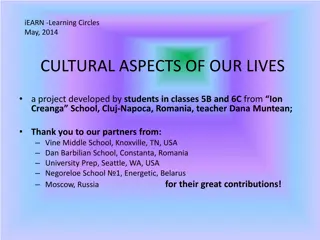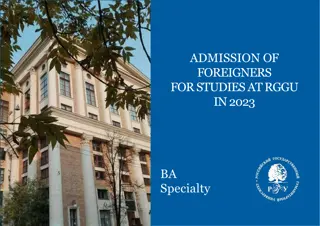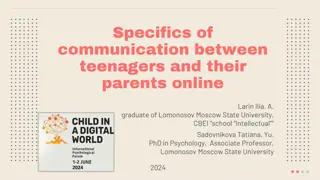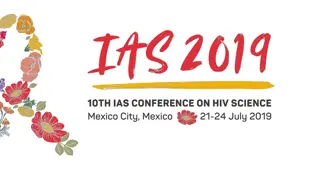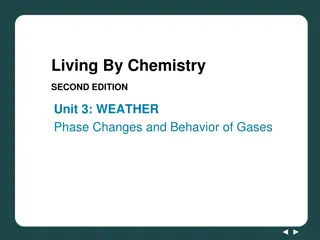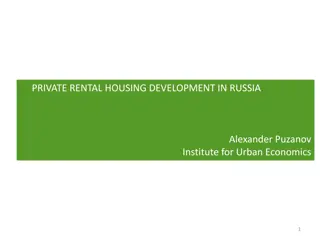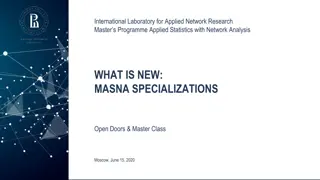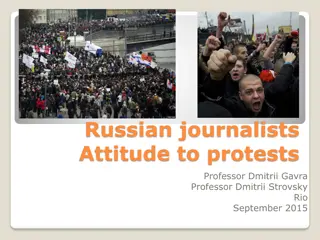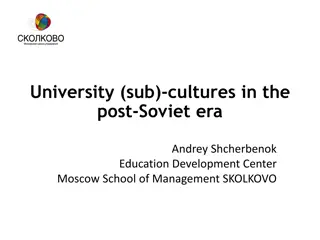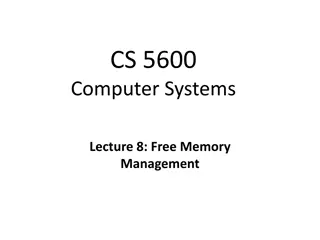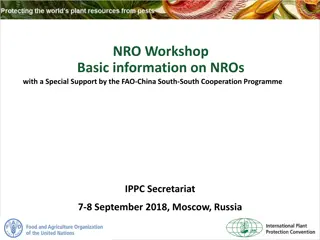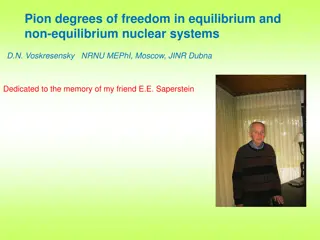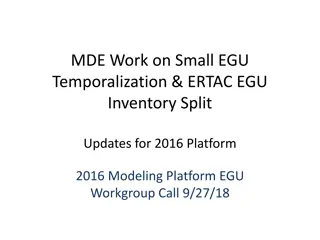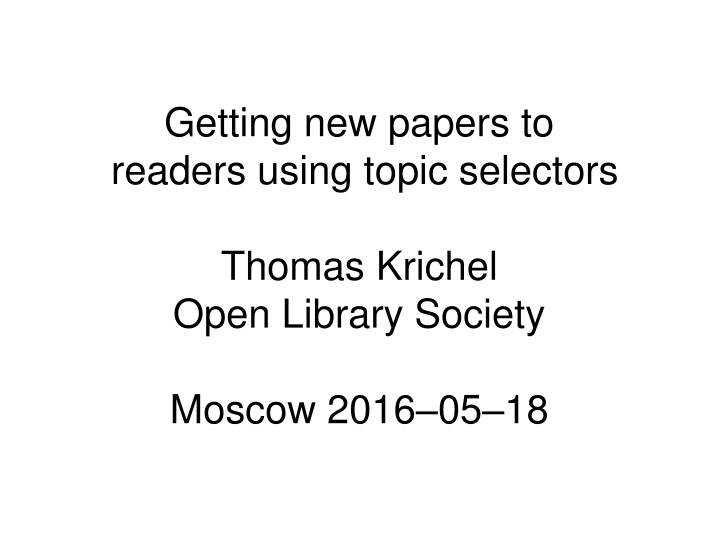
Innovative Approach to Academic Awareness Using Topic Selectors
Explore the innovative approach of using human volunteers as topic selectors to enhance academic awareness in the transition from an economy of information to an economy of attention. Learn how this method focuses on new papers and aims to improve readers' access to relevant content.
Download Presentation

Please find below an Image/Link to download the presentation.
The content on the website is provided AS IS for your information and personal use only. It may not be sold, licensed, or shared on other websites without obtaining consent from the author. If you encounter any issues during the download, it is possible that the publisher has removed the file from their server.
You are allowed to download the files provided on this website for personal or commercial use, subject to the condition that they are used lawfully. All files are the property of their respective owners.
The content on the website is provided AS IS for your information and personal use only. It may not be sold, licensed, or shared on other websites without obtaining consent from the author.
E N D
Presentation Transcript
Getting new papers to readers using topic selectors Thomas Krichel Open Library Society Moscow 2016 05 18
I am very nervous. My Russian is pretty lousy. I am hard to understand because I do pioneering work. I solve problems that I set out myself. I'm most famous for creating RePEc, but many people don't know what it is. I take a huge risk to have a life demo a bit later. And follow Tucholksy.
the big transition We live in a transition from a economy of information to an economy of attention. In an economy of information, information is scarce and attention is plentiful. In an economy of attention, information is plentiful and attention is scarce.
about the big transition It is a technical transition. It is not about right or wrong. It can help us to find who are the winners and the loosers. It can help us clear up some nonsense.
now to my main topic Academics read about one hour a week There is great pressure to publish There is little pressure to read. There is very little publishers can do to overcome that fact. They have to take it is as given.
aka academic awareness This refers to the idea that readers have to be aware of a papers existing before they would read it. It is an issue for closed and open access publishers alike. We are not talking about the delivery of full text here.
approaches to academic awareness There are several ways to do it. The one I have pioneered is using human volunteers. The volunteers look at documents coming in and decide whether they fit into a topic. Send the results to people how are interested in the topic. That's all. Really.
new versus old My approach is based on selectors looking through documents periodically. They can't be asked to look through all documents every time. So they only look at new documents. Thus my approach is really limited to looking at new documents only.
new documents are most interesting They are the ones that nobody knows about. They contain links to older papers via references. They are the ones current researchers need to know about to be aware of competing or complementary work. Academic awareness of new documents is usually called current awareness.
current awareness using selectors I have a library of documents. These documents are really descriptions of academic papers. I have some ways to find out what the new documents are. I gather all new documents periodically. I show the list of new documents to selectors. They say which ones are on a topic.
it's like a virtual serial The selector creates periodic (usually weekly) issues of a report. The report is an a topic. The report is circulated via email, or RSS, or other means. Thus report contents can be distributed in reusable formats. The fact that a document appeared in a report issue can be made public with the document data.
so what's the big deal here? The non-trivial aspect is to get this type of service of the ground. The is currently only one fully running service. It is the NEP: New Economics Papers Service. There is test service for social sciences, neSoS. and I am working on a biomedical service based on PubMed called biomed news .
what do we need? Raw material in the form of incoming documents. Labour in the form of selectors. Capital in the form of an infrastructure.
a library We need to have a collection of metadata about academic papers. There need to be enough quality papers described so that we get some shared documents of interest reasonable quality reasonable comprehensiveness There are not many such libraries available for reuse.
sample libraries arXiv (really a publisher, but in some sectors rather big) DBLP PubMed RePEc NEP: New Economics Papers others?
size, subject and quality matters The library has to be sufficiently large to warrant periodic split into topics. Documents in topics must have some academic heft to the them. For example, a lot of institutional repositories store student dissertation. While they are on topic they will not be what readers are interested in.
NEP size, subject & quality matters NEP only uses the working papers stock in RePEc. Published articles are considered too old. Working papers are published outside of thematic collections. It uses working papers without regard if they are freely available or not.
NEP size NEP issues come out weekly. The first NEP issue, in May 1998, had 24 documents. Now it is about 700 document per week. There are some duplications of documents. Some documents don't contain a date. So it is sometimes not easy to what document is new. The general policy is suspect that a document without date is new if there are not many documents from the same source added.
selectors Selectors should be subject specialists. They should work for no pay. That seems like a tall order. But recruiting selectors is not such a difficult task. In NEP most selectors are second-tier and junior academics.
what's in for selectors? They have to stay on top of the literature anyway. Looking through documents reveals new or different work. They can include the job as professional service item in the CV. They get name exposure an a well-read report.
opening new reports We can only open a new report when we have a new selector. As a result a set of reports is a likely to be result of ad hoc events. A set of reports does not create a classification scheme.
NEP selectors In NEP they are called editors. Most of them edit one report only. Most of them have been editing the same report for many years. Editorial changes are rare. I only recall one instance where a report has been closed, but that was for thematic reasons.
Readership of NEP reports NEP itself does not advertise itself. Thus much of the recruitment of readers is done by selectors. The more readers, the more the name recognition of an editor. There appears to be a disconnect between topic size and readership.
what do the selectors do They have a two tasks. They have a required task T1 to select documents. They have an optional task T1 to sort the documents. They may bring the document they find most interesting to the top.
task T1: selecting documents T1 itself is split into two sub-tasks. Task T11 is required. It is to select document that the selector thinks are actually relevant to the report. By default, no documents are included. Task T12 is optional. It is to select, among those documents that were relevant, the papers that will not go into the report issue. By default all documents are included.
why exclude a relevant document? It may be a duplicate of a previous document. It may be a survey paper. It may not be a appropriate for the audience. It may be plagiarized work. It may contradict something that the selector thinks. The author may have curly hair.
task T1: selecting relevant papers This is the key task. When the number of papers is large, it gets very time-consuming to this manually. That's where infrastructure comes in.
infrastructure We need a general web site. We need a system to mail report issues to subscribers and manage subscribers. We use Mailman open source list management software. We need a web interface to for the selectors to do their work.
ernad ernad stands for editing reports on new academic documents. It is a specialized system for editing reports. It was first designed by me, then written by Roman Shapiro in 2003. I maintain it since then. I have worked recently to make it flexible to implement different services, not just NEP.
presorting is the key feature of ernad The most important is the integration of machine learning into the selection process. Ernad tries to predict what documents are relevant and puts them to the beginning of the list presented to the authors. This allows editors to work through hundreds of proposed papers in just a few minutes.
sustainability NEP makes some money from adverts in report issues. To date about $4000 in two years. I have not done much to raise sponsorship. I'm working an a similar system for the biomedical sciences. Biomed news would have 40 times the input of NEP. This could bring substantial revenues.
remember Russia If there are journal article databases in Russia If they are available for periodic download then we can build a Russian version of a selector-driven current awareness system. I am pretty sure that in this political climate, it would not be too difficult to get startup funding for it.



